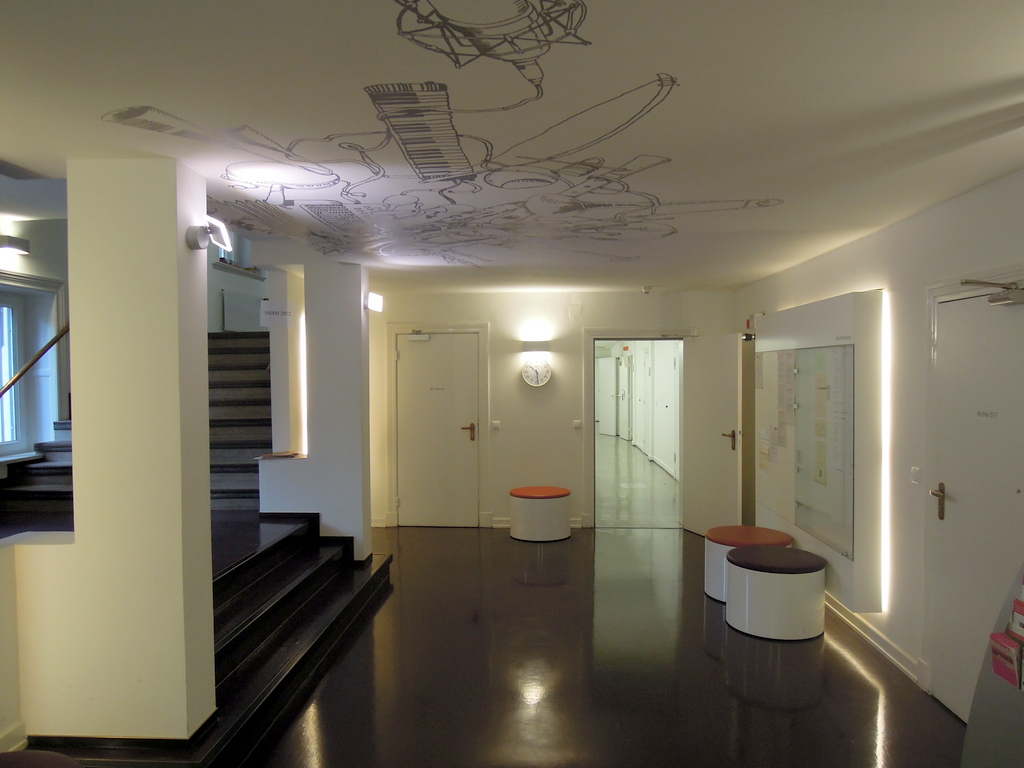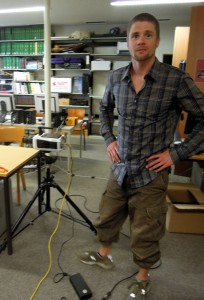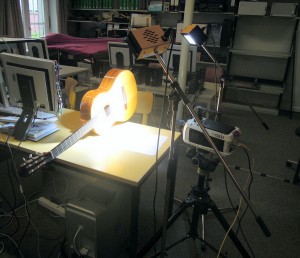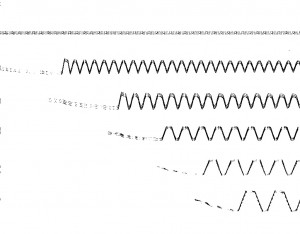I was in Hamburg last week, teaching at the International Summer Shool in Systematic Musicology (ISSSM). While there, I was able to test a newly acquired high-speed video camera (Phantom V711) at the Department of Musicology.
 ](/images/2012/08/2012-08-08-DSCN4127.jpg) The beautiful building of the Department of Musicology in Hamburg.
](/images/2012/08/2012-08-08-DSCN4127.jpg) The beautiful building of the Department of Musicology in Hamburg.
 ](/images/2012/08/2012-08-09-DSCN4152.jpg) They have some really cool drawings in the ceiling at the entrance of the Department of Musicology in Hamburg.
](/images/2012/08/2012-08-09-DSCN4152.jpg) They have some really cool drawings in the ceiling at the entrance of the Department of Musicology in Hamburg.
Master student Niko Plath was friendly enough to set aside some time to set up the system and do a test recording. Niko has been doing some fascinating work on measuring the motion of individual piano strings using the high-speed camera. For this type of study a camera-based approach makes it possible to measure the vibrations of individual strings without having to attach anything to the string or to the board.
 ](/images/2012/08/2012-08-09-DSCN4170.jpg) Niko Plath setting up the high-speed camera system.
](/images/2012/08/2012-08-09-DSCN4170.jpg) Niko Plath setting up the high-speed camera system.
While Niko has recorded the piano strings with a very high speed (500 KHz!) and low resolution(124 x 8 pixels), I was interested in seeing how the camera worked at the maximum resolution (1280 x 800 pixels). At this resolution, the maximum speed is 7 500 frames per second, and the maximum recording duration is 1.1 second.
Even though the recording is short, the processing and exporting of the file (21GB) takes quite some time. So I only had time to make one recording to try things out: a single strumming of all the (open) strings on a guitar, filming the vibrating strings over the sound board.
 ](/images/2012/08/2012-08-09-DSCN4167.jpg) The setup used for the recording: guitar, two LED lamps and the high-speed camera.
](/images/2012/08/2012-08-09-DSCN4167.jpg) The setup used for the recording: guitar, two LED lamps and the high-speed camera.
This was just a quick test, so there are several minor problems with the recording: one being that the guitar was placed upside down, so that the lower strings are at the bottom in the recording. Also, I did not hit the upper string very well, so that one only resonates a little in the beginning and decays quickly. Still, there is nothing as beautiful as watching high-speed recordings in slow-motion. Here you can see a version of the recording being played back at 100 frames per second:
Of course, I was interested in creating a motiongram of the recording. Rather than making this using a regular average technique, I rather used a slit-scan approach, selecting a single pixel column in the middle of the soundhole on the guitar. This was done using a few Jamoma modules in Max, and the patch looked like this:
 ](/images/2012/08/patch.png) The Max patch used to generate the motiongram from the high-speed video recording.
](/images/2012/08/patch.png) The Max patch used to generate the motiongram from the high-speed video recording.
The full motiongram is available here (TIFF 11 069 x 800 pixels), and below is a.jpg version in a more screen-friendly format. Even though the recording is only a little more than one second long, it is still possible to see the decay of the vibration of the strings, particularly the first strings (from above).
 ](/images/2012/08/Guitar_full-invert.jpg) Motiongram of the entire high-speed guitar recording.
](/images/2012/08/Guitar_full-invert.jpg) Motiongram of the entire high-speed guitar recording.
Below is a version showing only the beginning of the motiongram, and how the individual strings were strummed. Notice the difference in the “cut-off” of the shape of the wave of each of the strings.
 ](/images/2012/08/Guitar_full-invert-intro.jpg) The first 1000 frames of the recording, showing how the strings were strummed.
](/images/2012/08/Guitar_full-invert-intro.jpg) The first 1000 frames of the recording, showing how the strings were strummed.
No new scientific insights here, but it is always fun to see periodic motion with the naked eye. It is a good reminder that auditory and visual phenomena (and the perception of them) are related. Thanks to Niko for helping out, and to his supervisor Rolf Bader for letting me try the system.